HRM Analysis: British Airways and Service Industry Dynamics
VerifiedAdded on 2021/02/19
|20
|5451
|22
Report
AI Summary
This report provides a detailed analysis of Human Resource Management (HRM) practices within British Airways, a leading airline in the UK's service industry. The report begins with an introduction to HRM, defining its core concepts and significance in managing the workforce. It then delves into the specific application of HRM principles at British Airways, examining aspects such as planning and forecasting, recruitment processes, employment contracts, HR strategies, reward systems, and performance management. The report highlights the nature of the airline industry and the crucial role of staff, followed by an overview of HRM roles, including recruitment and selection, employee relations, and training and development. The purpose of HRM, encompassing both soft and hard approaches, is also discussed. Furthermore, the report explores HR planning, including the identification of emerging HR needs, gap analysis, and the development of gap strategies. The influence of both internal and external factors on HR planning is assessed, alongside a consideration of HR planning in a dynamic environment. The report includes a detailed analysis of the demand and supply of employees within the aviation sector, addressing factors influencing HR planning and the employment relations. Finally, it covers employment relations, outlining strategies and practices for building positive employer-employee relationships, providing fair treatment, and fostering employee commitment.
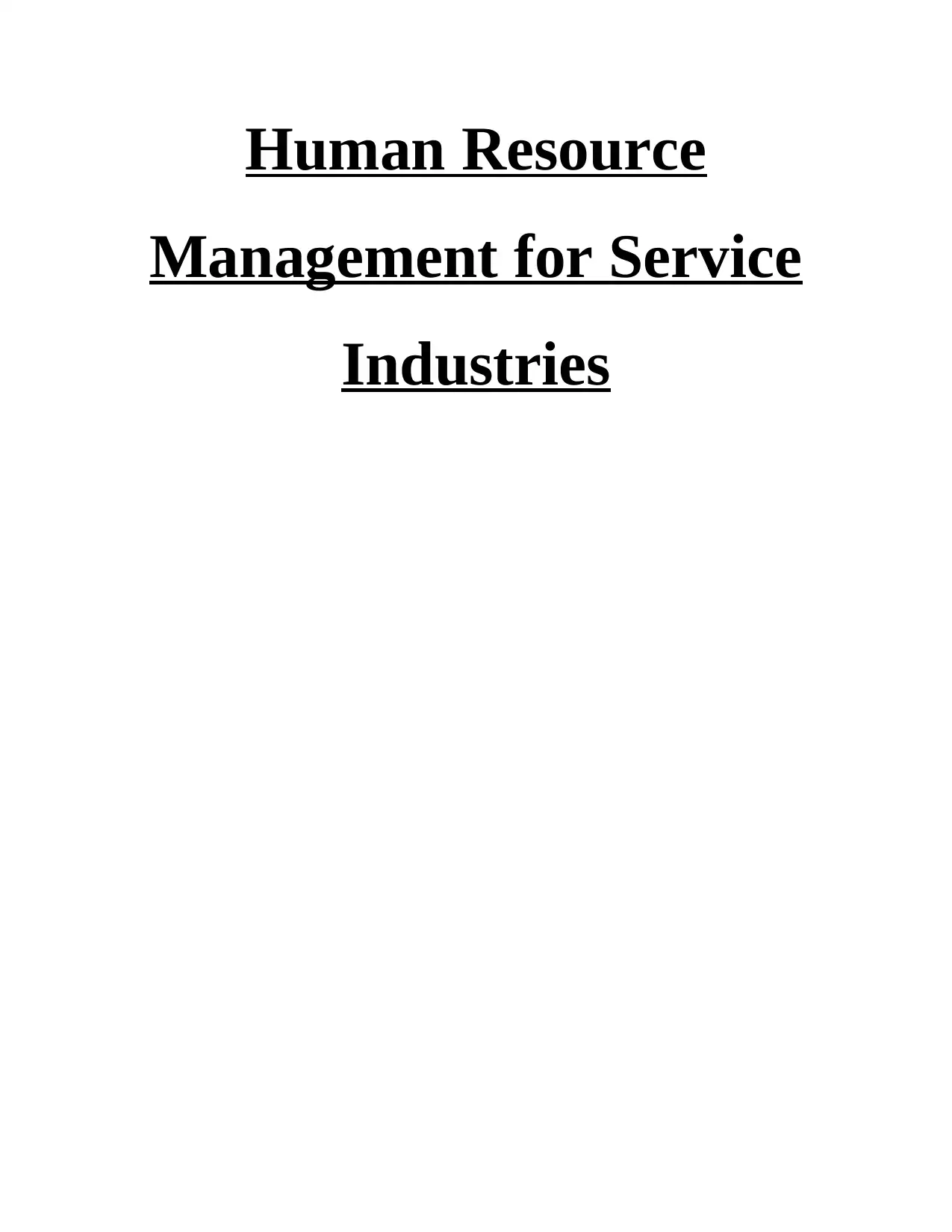
Human Resource
Management for Service
Industries
Management for Service
Industries
Paraphrase This Document
Need a fresh take? Get an instant paraphrase of this document with our AI Paraphraser
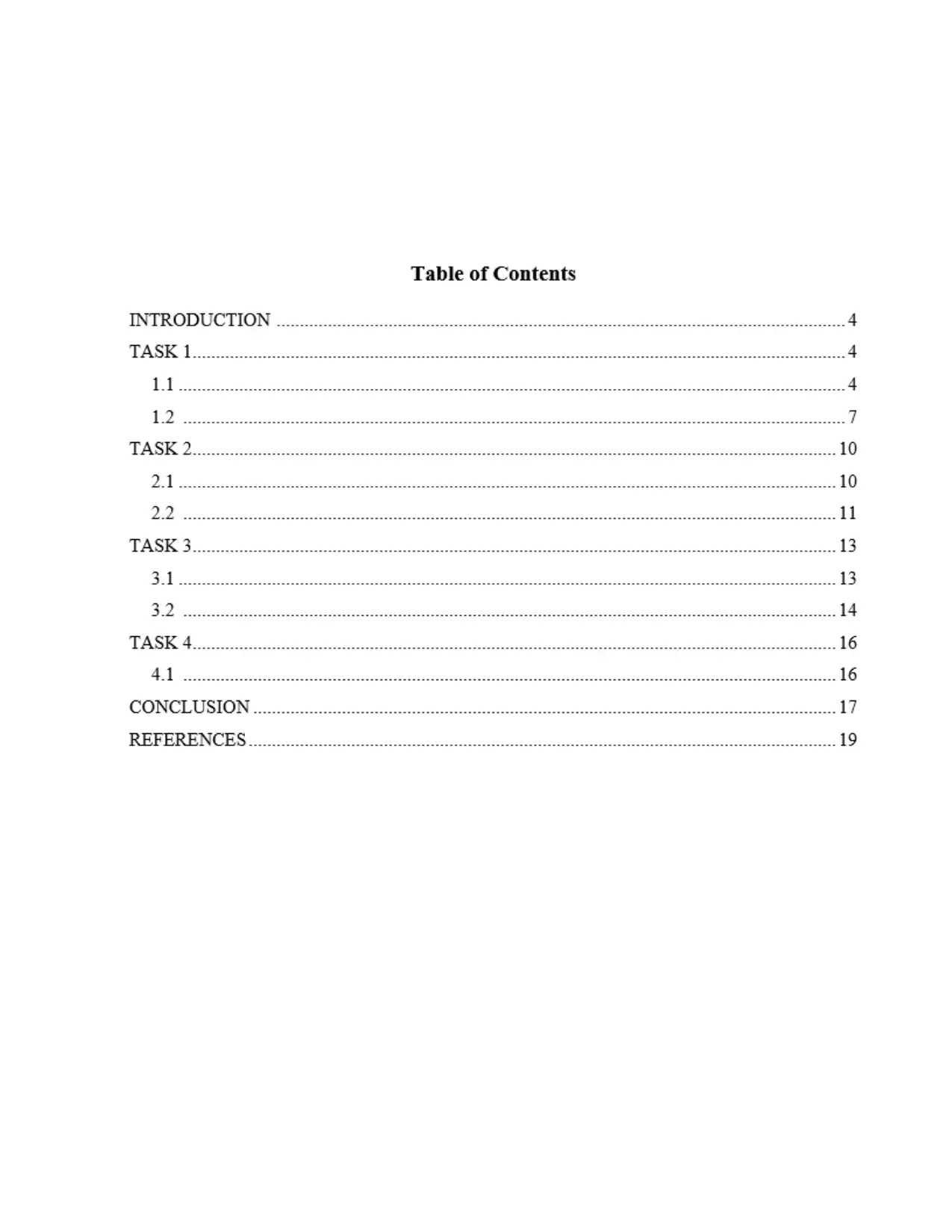

⊘ This is a preview!⊘
Do you want full access?
Subscribe today to unlock all pages.

Trusted by 1+ million students worldwide
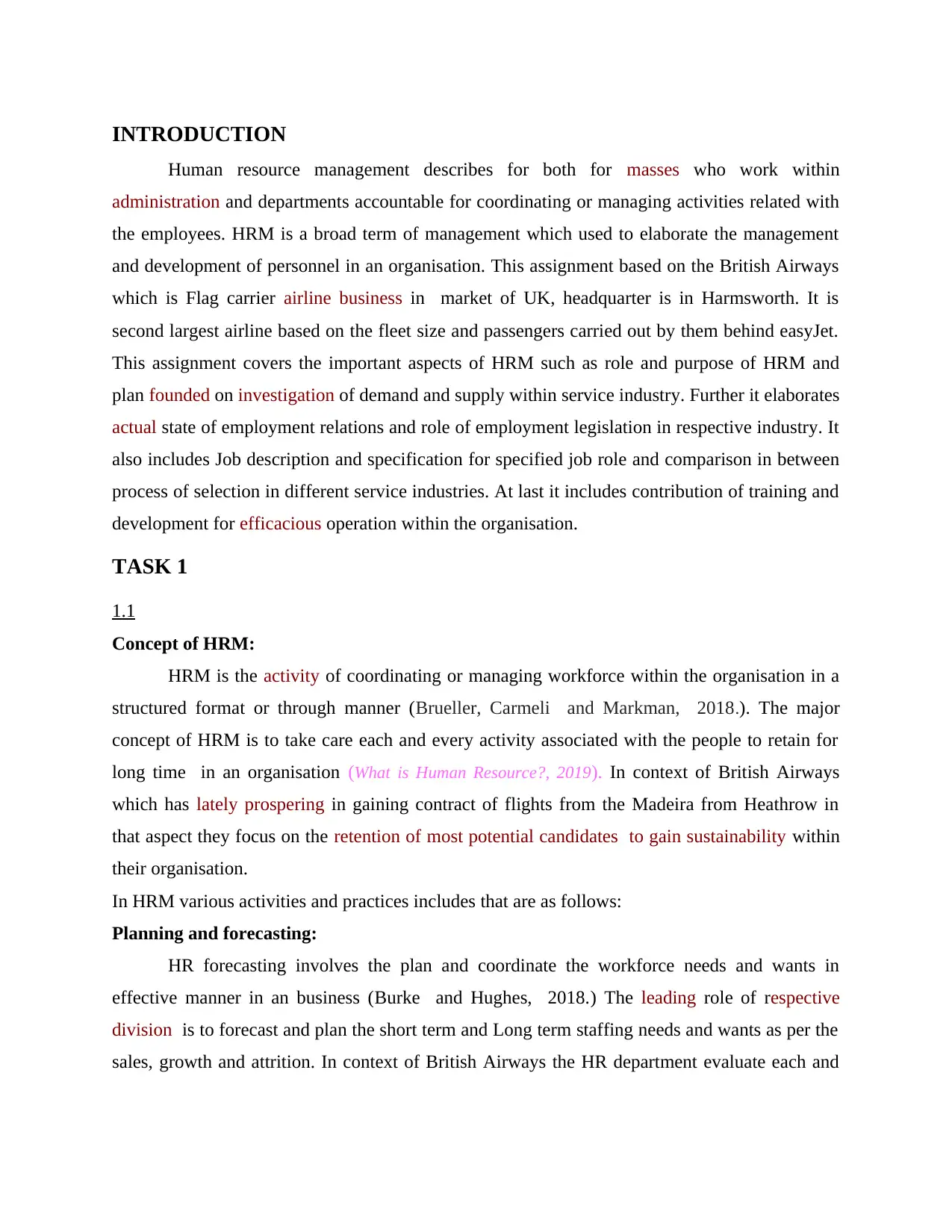
INTRODUCTION
Human resource management describes for both for masses who work within
administration and departments accountable for coordinating or managing activities related with
the employees. HRM is a broad term of management which used to elaborate the management
and development of personnel in an organisation. This assignment based on the British Airways
which is Flag carrier airline business in market of UK, headquarter is in Harmsworth. It is
second largest airline based on the fleet size and passengers carried out by them behind easyJet.
This assignment covers the important aspects of HRM such as role and purpose of HRM and
plan founded on investigation of demand and supply within service industry. Further it elaborates
actual state of employment relations and role of employment legislation in respective industry. It
also includes Job description and specification for specified job role and comparison in between
process of selection in different service industries. At last it includes contribution of training and
development for efficacious operation within the organisation.
TASK 1
1.1
Concept of HRM:
HRM is the activity of coordinating or managing workforce within the organisation in a
structured format or through manner (Brueller, Carmeli and Markman, 2018.). The major
concept of HRM is to take care each and every activity associated with the people to retain for
long time in an organisation (What is Human Resource?, 2019). In context of British Airways
which has lately prospering in gaining contract of flights from the Madeira from Heathrow in
that aspect they focus on the retention of most potential candidates to gain sustainability within
their organisation.
In HRM various activities and practices includes that are as follows:
Planning and forecasting:
HR forecasting involves the plan and coordinate the workforce needs and wants in
effective manner in an business (Burke and Hughes, 2018.) The leading role of respective
division is to forecast and plan the short term and Long term staffing needs and wants as per the
sales, growth and attrition. In context of British Airways the HR department evaluate each and
Human resource management describes for both for masses who work within
administration and departments accountable for coordinating or managing activities related with
the employees. HRM is a broad term of management which used to elaborate the management
and development of personnel in an organisation. This assignment based on the British Airways
which is Flag carrier airline business in market of UK, headquarter is in Harmsworth. It is
second largest airline based on the fleet size and passengers carried out by them behind easyJet.
This assignment covers the important aspects of HRM such as role and purpose of HRM and
plan founded on investigation of demand and supply within service industry. Further it elaborates
actual state of employment relations and role of employment legislation in respective industry. It
also includes Job description and specification for specified job role and comparison in between
process of selection in different service industries. At last it includes contribution of training and
development for efficacious operation within the organisation.
TASK 1
1.1
Concept of HRM:
HRM is the activity of coordinating or managing workforce within the organisation in a
structured format or through manner (Brueller, Carmeli and Markman, 2018.). The major
concept of HRM is to take care each and every activity associated with the people to retain for
long time in an organisation (What is Human Resource?, 2019). In context of British Airways
which has lately prospering in gaining contract of flights from the Madeira from Heathrow in
that aspect they focus on the retention of most potential candidates to gain sustainability within
their organisation.
In HRM various activities and practices includes that are as follows:
Planning and forecasting:
HR forecasting involves the plan and coordinate the workforce needs and wants in
effective manner in an business (Burke and Hughes, 2018.) The leading role of respective
division is to forecast and plan the short term and Long term staffing needs and wants as per the
sales, growth and attrition. In context of British Airways the HR department evaluate each and
Paraphrase This Document
Need a fresh take? Get an instant paraphrase of this document with our AI Paraphraser
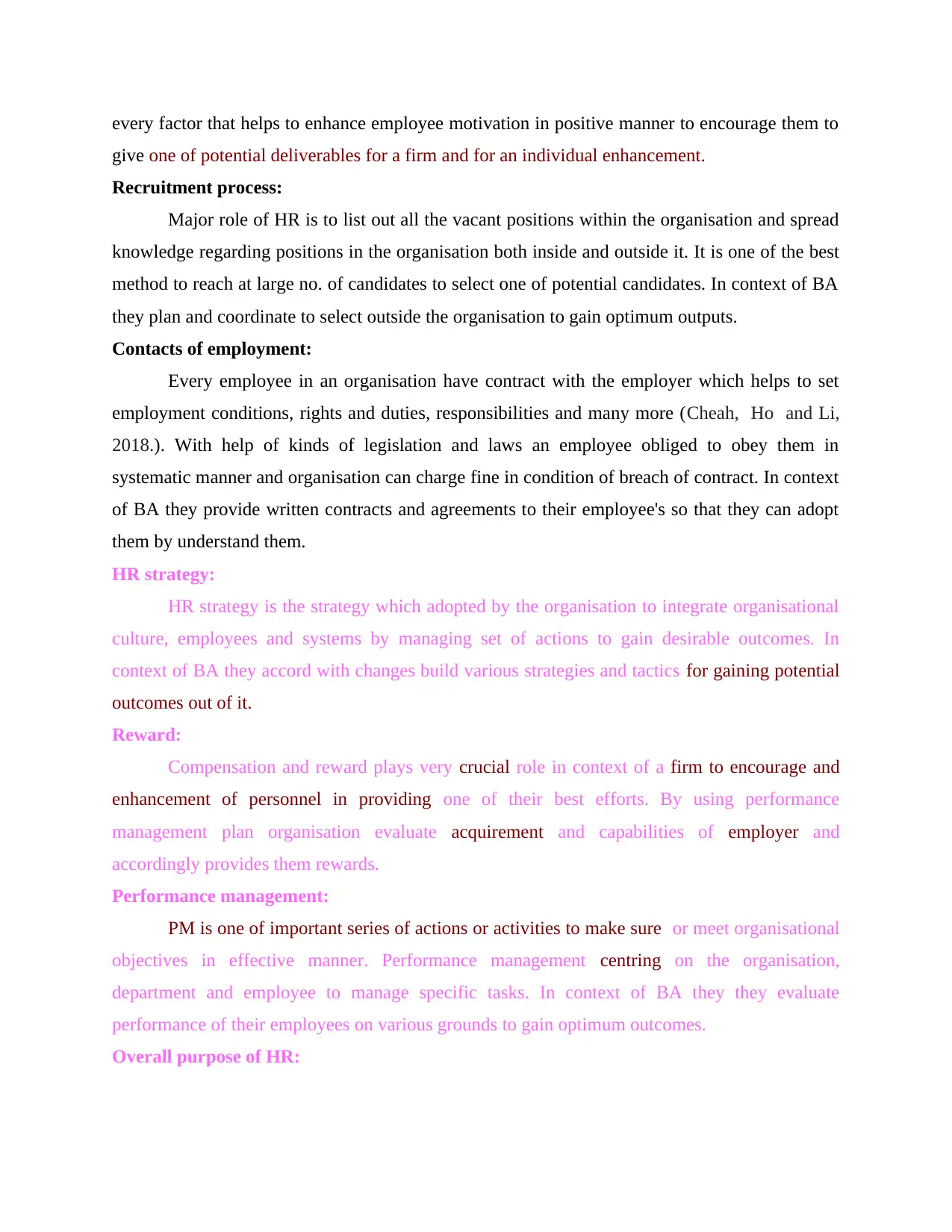
every factor that helps to enhance employee motivation in positive manner to encourage them to
give one of potential deliverables for a firm and for an individual enhancement.
Recruitment process:
Major role of HR is to list out all the vacant positions within the organisation and spread
knowledge regarding positions in the organisation both inside and outside it. It is one of the best
method to reach at large no. of candidates to select one of potential candidates. In context of BA
they plan and coordinate to select outside the organisation to gain optimum outputs.
Contacts of employment:
Every employee in an organisation have contract with the employer which helps to set
employment conditions, rights and duties, responsibilities and many more (Cheah, Ho and Li,
2018.). With help of kinds of legislation and laws an employee obliged to obey them in
systematic manner and organisation can charge fine in condition of breach of contract. In context
of BA they provide written contracts and agreements to their employee's so that they can adopt
them by understand them.
HR strategy:
HR strategy is the strategy which adopted by the organisation to integrate organisational
culture, employees and systems by managing set of actions to gain desirable outcomes. In
context of BA they accord with changes build various strategies and tactics for gaining potential
outcomes out of it.
Reward:
Compensation and reward plays very crucial role in context of a firm to encourage and
enhancement of personnel in providing one of their best efforts. By using performance
management plan organisation evaluate acquirement and capabilities of employer and
accordingly provides them rewards.
Performance management:
PM is one of important series of actions or activities to make sure or meet organisational
objectives in effective manner. Performance management centring on the organisation,
department and employee to manage specific tasks. In context of BA they they evaluate
performance of their employees on various grounds to gain optimum outcomes.
Overall purpose of HR:
give one of potential deliverables for a firm and for an individual enhancement.
Recruitment process:
Major role of HR is to list out all the vacant positions within the organisation and spread
knowledge regarding positions in the organisation both inside and outside it. It is one of the best
method to reach at large no. of candidates to select one of potential candidates. In context of BA
they plan and coordinate to select outside the organisation to gain optimum outputs.
Contacts of employment:
Every employee in an organisation have contract with the employer which helps to set
employment conditions, rights and duties, responsibilities and many more (Cheah, Ho and Li,
2018.). With help of kinds of legislation and laws an employee obliged to obey them in
systematic manner and organisation can charge fine in condition of breach of contract. In context
of BA they provide written contracts and agreements to their employee's so that they can adopt
them by understand them.
HR strategy:
HR strategy is the strategy which adopted by the organisation to integrate organisational
culture, employees and systems by managing set of actions to gain desirable outcomes. In
context of BA they accord with changes build various strategies and tactics for gaining potential
outcomes out of it.
Reward:
Compensation and reward plays very crucial role in context of a firm to encourage and
enhancement of personnel in providing one of their best efforts. By using performance
management plan organisation evaluate acquirement and capabilities of employer and
accordingly provides them rewards.
Performance management:
PM is one of important series of actions or activities to make sure or meet organisational
objectives in effective manner. Performance management centring on the organisation,
department and employee to manage specific tasks. In context of BA they they evaluate
performance of their employees on various grounds to gain optimum outcomes.
Overall purpose of HR:
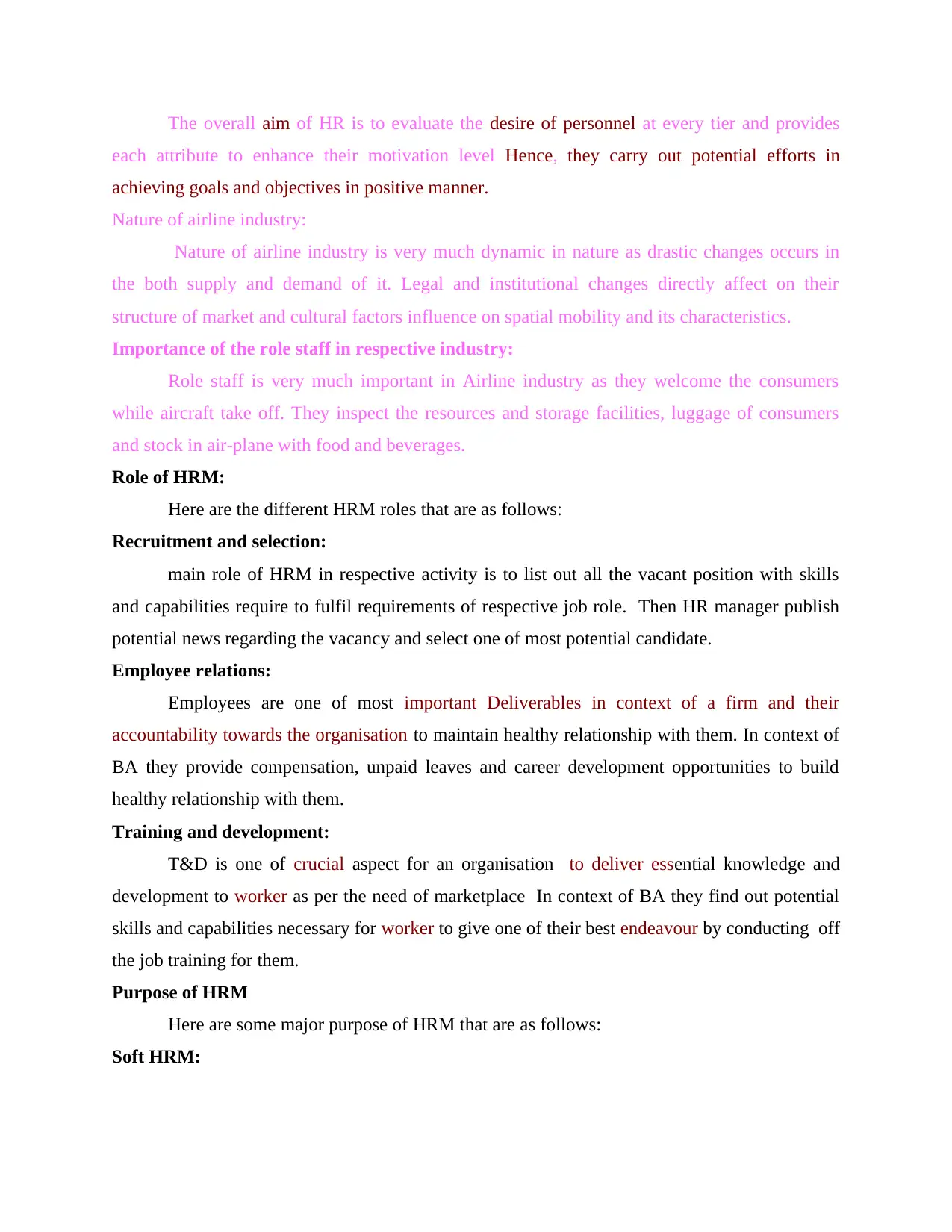
The overall aim of HR is to evaluate the desire of personnel at every tier and provides
each attribute to enhance their motivation level Hence, they carry out potential efforts in
achieving goals and objectives in positive manner.
Nature of airline industry:
Nature of airline industry is very much dynamic in nature as drastic changes occurs in
the both supply and demand of it. Legal and institutional changes directly affect on their
structure of market and cultural factors influence on spatial mobility and its characteristics.
Importance of the role staff in respective industry:
Role staff is very much important in Airline industry as they welcome the consumers
while aircraft take off. They inspect the resources and storage facilities, luggage of consumers
and stock in air-plane with food and beverages.
Role of HRM:
Here are the different HRM roles that are as follows:
Recruitment and selection:
main role of HRM in respective activity is to list out all the vacant position with skills
and capabilities require to fulfil requirements of respective job role. Then HR manager publish
potential news regarding the vacancy and select one of most potential candidate.
Employee relations:
Employees are one of most important Deliverables in context of a firm and their
accountability towards the organisation to maintain healthy relationship with them. In context of
BA they provide compensation, unpaid leaves and career development opportunities to build
healthy relationship with them.
Training and development:
T&D is one of crucial aspect for an organisation to deliver essential knowledge and
development to worker as per the need of marketplace In context of BA they find out potential
skills and capabilities necessary for worker to give one of their best endeavour by conducting off
the job training for them.
Purpose of HRM
Here are some major purpose of HRM that are as follows:
Soft HRM:
each attribute to enhance their motivation level Hence, they carry out potential efforts in
achieving goals and objectives in positive manner.
Nature of airline industry:
Nature of airline industry is very much dynamic in nature as drastic changes occurs in
the both supply and demand of it. Legal and institutional changes directly affect on their
structure of market and cultural factors influence on spatial mobility and its characteristics.
Importance of the role staff in respective industry:
Role staff is very much important in Airline industry as they welcome the consumers
while aircraft take off. They inspect the resources and storage facilities, luggage of consumers
and stock in air-plane with food and beverages.
Role of HRM:
Here are the different HRM roles that are as follows:
Recruitment and selection:
main role of HRM in respective activity is to list out all the vacant position with skills
and capabilities require to fulfil requirements of respective job role. Then HR manager publish
potential news regarding the vacancy and select one of most potential candidate.
Employee relations:
Employees are one of most important Deliverables in context of a firm and their
accountability towards the organisation to maintain healthy relationship with them. In context of
BA they provide compensation, unpaid leaves and career development opportunities to build
healthy relationship with them.
Training and development:
T&D is one of crucial aspect for an organisation to deliver essential knowledge and
development to worker as per the need of marketplace In context of BA they find out potential
skills and capabilities necessary for worker to give one of their best endeavour by conducting off
the job training for them.
Purpose of HRM
Here are some major purpose of HRM that are as follows:
Soft HRM:
⊘ This is a preview!⊘
Do you want full access?
Subscribe today to unlock all pages.

Trusted by 1+ million students worldwide
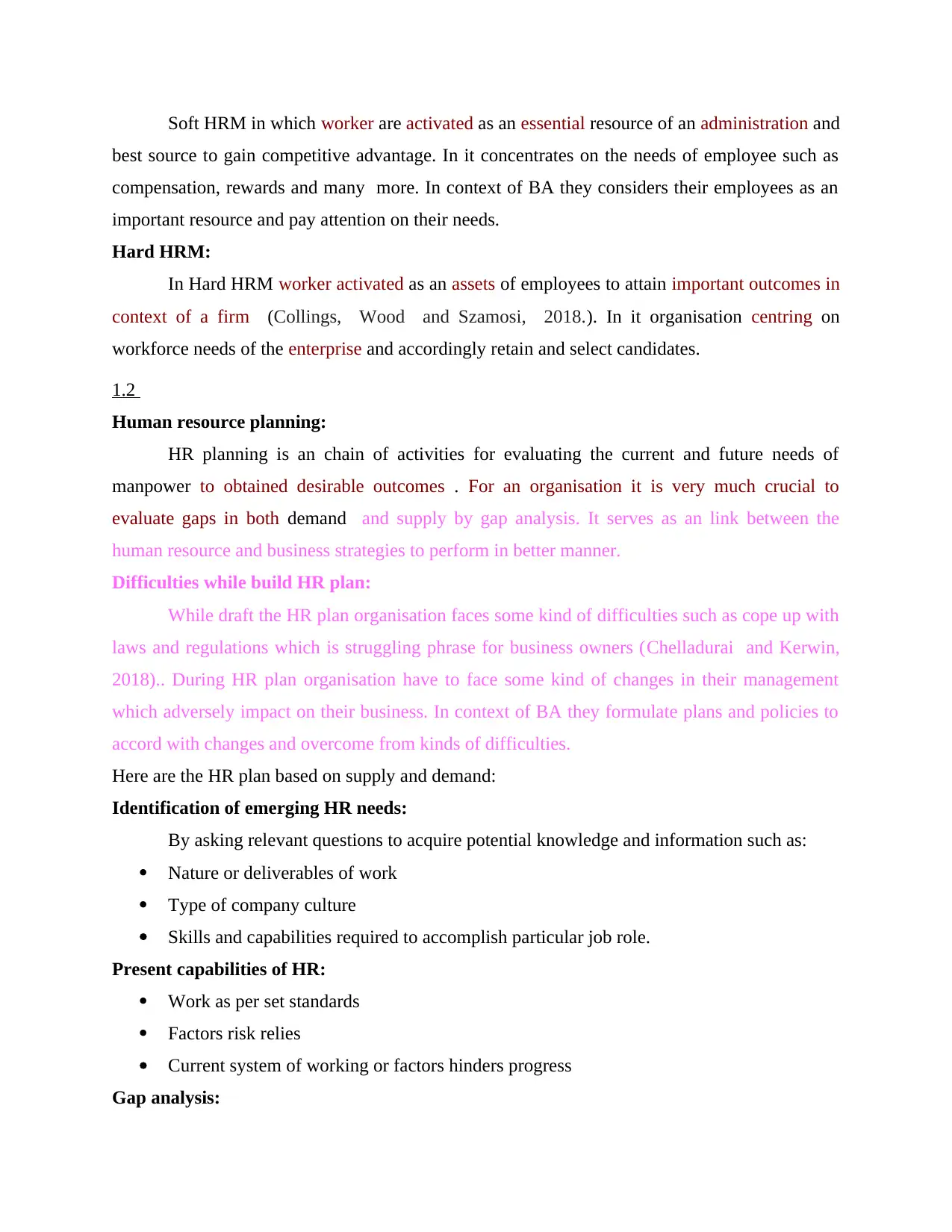
Soft HRM in which worker are activated as an essential resource of an administration and
best source to gain competitive advantage. In it concentrates on the needs of employee such as
compensation, rewards and many more. In context of BA they considers their employees as an
important resource and pay attention on their needs.
Hard HRM:
In Hard HRM worker activated as an assets of employees to attain important outcomes in
context of a firm (Collings, Wood and Szamosi, 2018.). In it organisation centring on
workforce needs of the enterprise and accordingly retain and select candidates.
1.2
Human resource planning:
HR planning is an chain of activities for evaluating the current and future needs of
manpower to obtained desirable outcomes . For an organisation it is very much crucial to
evaluate gaps in both demand and supply by gap analysis. It serves as an link between the
human resource and business strategies to perform in better manner.
Difficulties while build HR plan:
While draft the HR plan organisation faces some kind of difficulties such as cope up with
laws and regulations which is struggling phrase for business owners (Chelladurai and Kerwin,
2018).. During HR plan organisation have to face some kind of changes in their management
which adversely impact on their business. In context of BA they formulate plans and policies to
accord with changes and overcome from kinds of difficulties.
Here are the HR plan based on supply and demand:
Identification of emerging HR needs:
By asking relevant questions to acquire potential knowledge and information such as:
Nature or deliverables of work
Type of company culture
Skills and capabilities required to accomplish particular job role.
Present capabilities of HR:
Work as per set standards
Factors risk relies
Current system of working or factors hinders progress
Gap analysis:
best source to gain competitive advantage. In it concentrates on the needs of employee such as
compensation, rewards and many more. In context of BA they considers their employees as an
important resource and pay attention on their needs.
Hard HRM:
In Hard HRM worker activated as an assets of employees to attain important outcomes in
context of a firm (Collings, Wood and Szamosi, 2018.). In it organisation centring on
workforce needs of the enterprise and accordingly retain and select candidates.
1.2
Human resource planning:
HR planning is an chain of activities for evaluating the current and future needs of
manpower to obtained desirable outcomes . For an organisation it is very much crucial to
evaluate gaps in both demand and supply by gap analysis. It serves as an link between the
human resource and business strategies to perform in better manner.
Difficulties while build HR plan:
While draft the HR plan organisation faces some kind of difficulties such as cope up with
laws and regulations which is struggling phrase for business owners (Chelladurai and Kerwin,
2018).. During HR plan organisation have to face some kind of changes in their management
which adversely impact on their business. In context of BA they formulate plans and policies to
accord with changes and overcome from kinds of difficulties.
Here are the HR plan based on supply and demand:
Identification of emerging HR needs:
By asking relevant questions to acquire potential knowledge and information such as:
Nature or deliverables of work
Type of company culture
Skills and capabilities required to accomplish particular job role.
Present capabilities of HR:
Work as per set standards
Factors risk relies
Current system of working or factors hinders progress
Gap analysis:
Paraphrase This Document
Need a fresh take? Get an instant paraphrase of this document with our AI Paraphraser
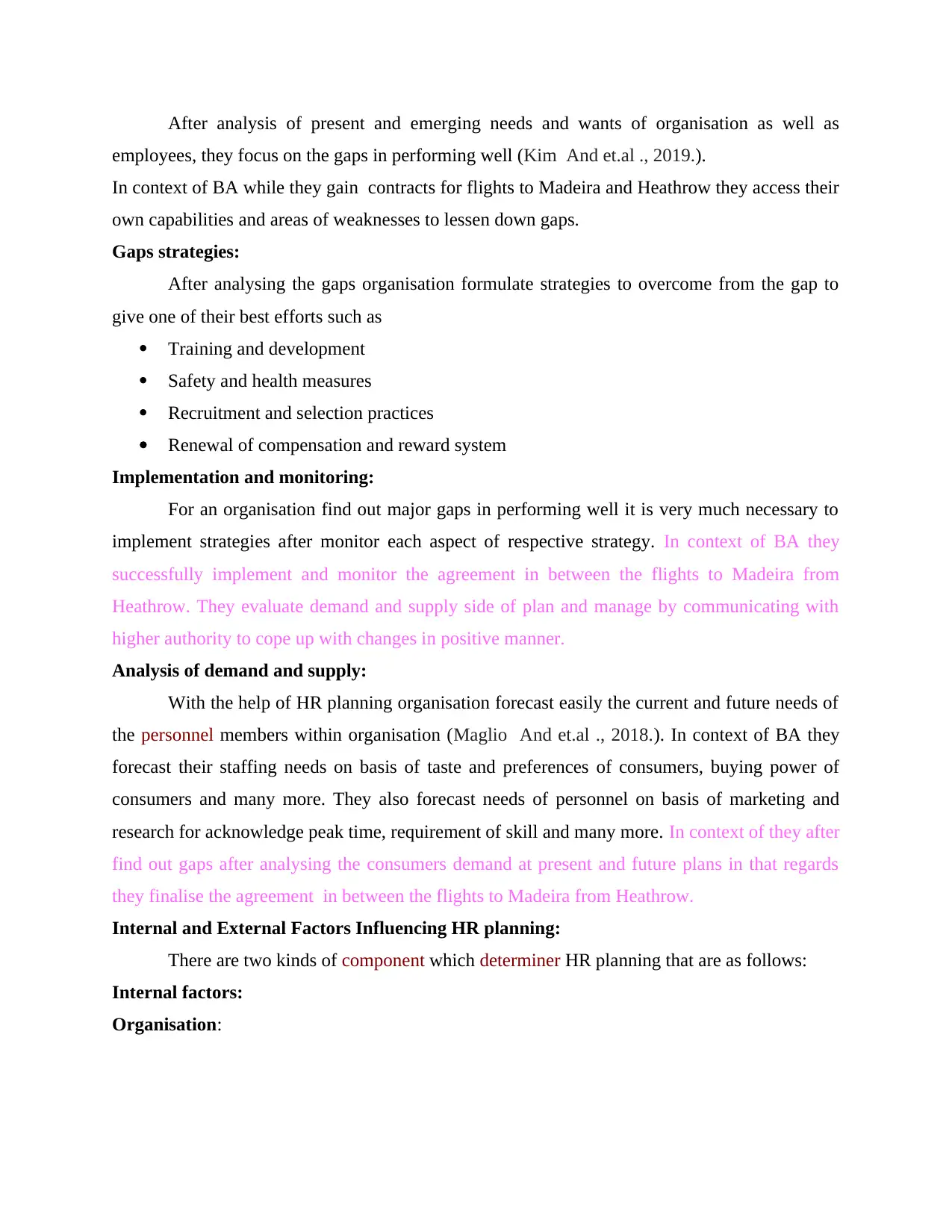
After analysis of present and emerging needs and wants of organisation as well as
employees, they focus on the gaps in performing well (Kim And et.al ., 2019.).
In context of BA while they gain contracts for flights to Madeira and Heathrow they access their
own capabilities and areas of weaknesses to lessen down gaps.
Gaps strategies:
After analysing the gaps organisation formulate strategies to overcome from the gap to
give one of their best efforts such as
Training and development
Safety and health measures
Recruitment and selection practices
Renewal of compensation and reward system
Implementation and monitoring:
For an organisation find out major gaps in performing well it is very much necessary to
implement strategies after monitor each aspect of respective strategy. In context of BA they
successfully implement and monitor the agreement in between the flights to Madeira from
Heathrow. They evaluate demand and supply side of plan and manage by communicating with
higher authority to cope up with changes in positive manner.
Analysis of demand and supply:
With the help of HR planning organisation forecast easily the current and future needs of
the personnel members within organisation (Maglio And et.al ., 2018.). In context of BA they
forecast their staffing needs on basis of taste and preferences of consumers, buying power of
consumers and many more. They also forecast needs of personnel on basis of marketing and
research for acknowledge peak time, requirement of skill and many more. In context of they after
find out gaps after analysing the consumers demand at present and future plans in that regards
they finalise the agreement in between the flights to Madeira from Heathrow.
Internal and External Factors Influencing HR planning:
There are two kinds of component which determiner HR planning that are as follows:
Internal factors:
Organisation:
employees, they focus on the gaps in performing well (Kim And et.al ., 2019.).
In context of BA while they gain contracts for flights to Madeira and Heathrow they access their
own capabilities and areas of weaknesses to lessen down gaps.
Gaps strategies:
After analysing the gaps organisation formulate strategies to overcome from the gap to
give one of their best efforts such as
Training and development
Safety and health measures
Recruitment and selection practices
Renewal of compensation and reward system
Implementation and monitoring:
For an organisation find out major gaps in performing well it is very much necessary to
implement strategies after monitor each aspect of respective strategy. In context of BA they
successfully implement and monitor the agreement in between the flights to Madeira from
Heathrow. They evaluate demand and supply side of plan and manage by communicating with
higher authority to cope up with changes in positive manner.
Analysis of demand and supply:
With the help of HR planning organisation forecast easily the current and future needs of
the personnel members within organisation (Maglio And et.al ., 2018.). In context of BA they
forecast their staffing needs on basis of taste and preferences of consumers, buying power of
consumers and many more. They also forecast needs of personnel on basis of marketing and
research for acknowledge peak time, requirement of skill and many more. In context of they after
find out gaps after analysing the consumers demand at present and future plans in that regards
they finalise the agreement in between the flights to Madeira from Heathrow.
Internal and External Factors Influencing HR planning:
There are two kinds of component which determiner HR planning that are as follows:
Internal factors:
Organisation:
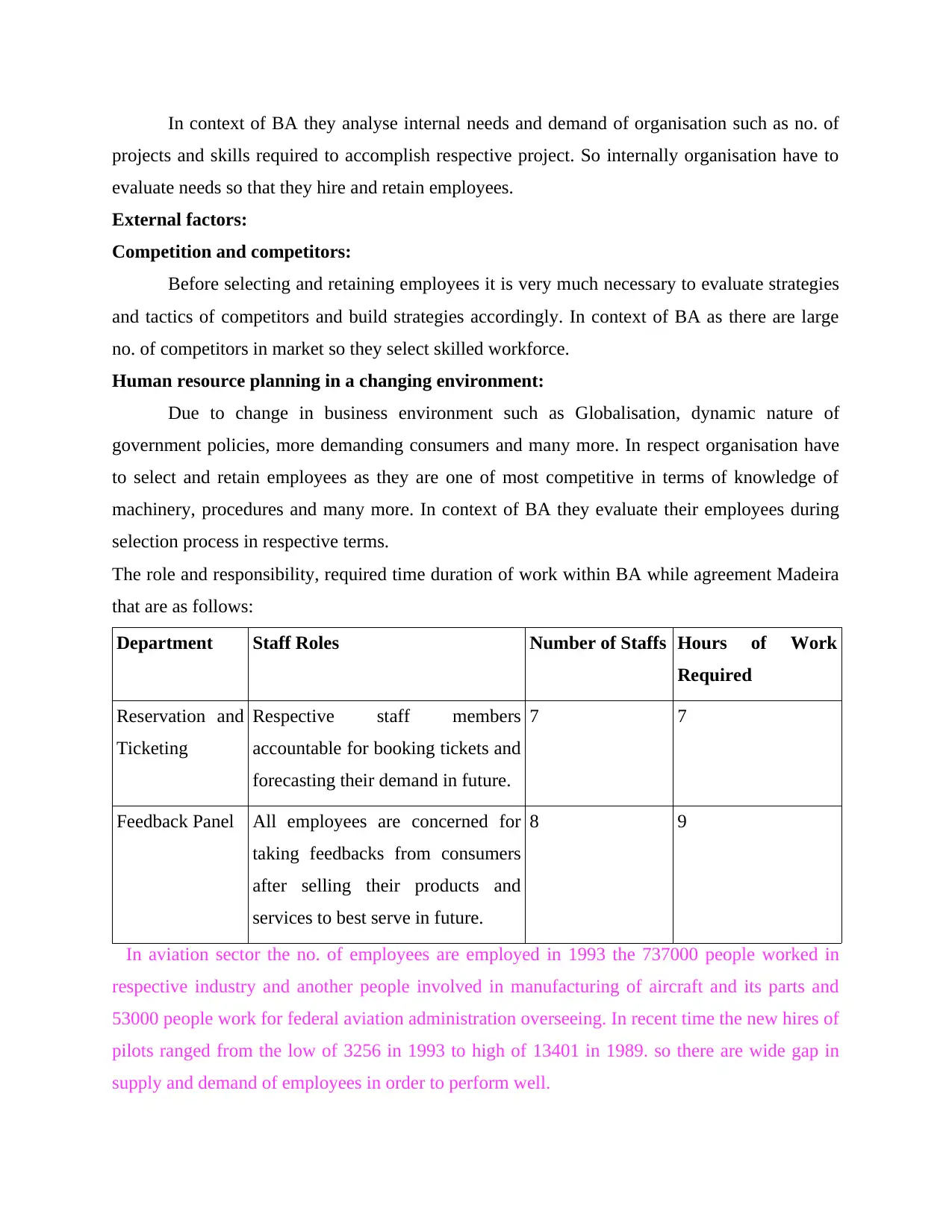
In context of BA they analyse internal needs and demand of organisation such as no. of
projects and skills required to accomplish respective project. So internally organisation have to
evaluate needs so that they hire and retain employees.
External factors:
Competition and competitors:
Before selecting and retaining employees it is very much necessary to evaluate strategies
and tactics of competitors and build strategies accordingly. In context of BA as there are large
no. of competitors in market so they select skilled workforce.
Human resource planning in a changing environment:
Due to change in business environment such as Globalisation, dynamic nature of
government policies, more demanding consumers and many more. In respect organisation have
to select and retain employees as they are one of most competitive in terms of knowledge of
machinery, procedures and many more. In context of BA they evaluate their employees during
selection process in respective terms.
The role and responsibility, required time duration of work within BA while agreement Madeira
that are as follows:
Department Staff Roles Number of Staffs Hours of Work
Required
Reservation and
Ticketing
Respective staff members
accountable for booking tickets and
forecasting their demand in future.
7 7
Feedback Panel All employees are concerned for
taking feedbacks from consumers
after selling their products and
services to best serve in future.
8 9
In aviation sector the no. of employees are employed in 1993 the 737000 people worked in
respective industry and another people involved in manufacturing of aircraft and its parts and
53000 people work for federal aviation administration overseeing. In recent time the new hires of
pilots ranged from the low of 3256 in 1993 to high of 13401 in 1989. so there are wide gap in
supply and demand of employees in order to perform well.
projects and skills required to accomplish respective project. So internally organisation have to
evaluate needs so that they hire and retain employees.
External factors:
Competition and competitors:
Before selecting and retaining employees it is very much necessary to evaluate strategies
and tactics of competitors and build strategies accordingly. In context of BA as there are large
no. of competitors in market so they select skilled workforce.
Human resource planning in a changing environment:
Due to change in business environment such as Globalisation, dynamic nature of
government policies, more demanding consumers and many more. In respect organisation have
to select and retain employees as they are one of most competitive in terms of knowledge of
machinery, procedures and many more. In context of BA they evaluate their employees during
selection process in respective terms.
The role and responsibility, required time duration of work within BA while agreement Madeira
that are as follows:
Department Staff Roles Number of Staffs Hours of Work
Required
Reservation and
Ticketing
Respective staff members
accountable for booking tickets and
forecasting their demand in future.
7 7
Feedback Panel All employees are concerned for
taking feedbacks from consumers
after selling their products and
services to best serve in future.
8 9
In aviation sector the no. of employees are employed in 1993 the 737000 people worked in
respective industry and another people involved in manufacturing of aircraft and its parts and
53000 people work for federal aviation administration overseeing. In recent time the new hires of
pilots ranged from the low of 3256 in 1993 to high of 13401 in 1989. so there are wide gap in
supply and demand of employees in order to perform well.
⊘ This is a preview!⊘
Do you want full access?
Subscribe today to unlock all pages.

Trusted by 1+ million students worldwide
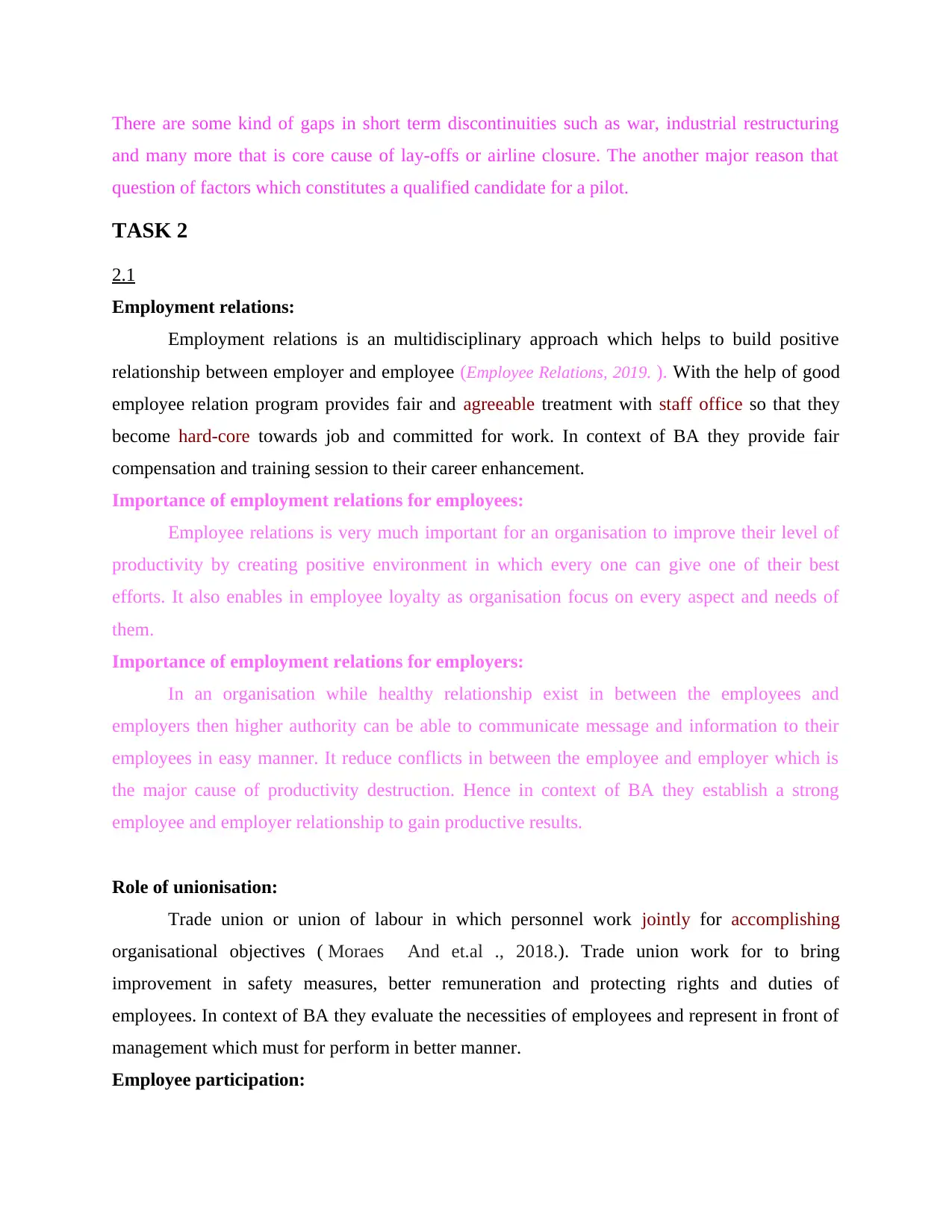
There are some kind of gaps in short term discontinuities such as war, industrial restructuring
and many more that is core cause of lay-offs or airline closure. The another major reason that
question of factors which constitutes a qualified candidate for a pilot.
TASK 2
2.1
Employment relations:
Employment relations is an multidisciplinary approach which helps to build positive
relationship between employer and employee (Employee Relations, 2019. ). With the help of good
employee relation program provides fair and agreeable treatment with staff office so that they
become hard-core towards job and committed for work. In context of BA they provide fair
compensation and training session to their career enhancement.
Importance of employment relations for employees:
Employee relations is very much important for an organisation to improve their level of
productivity by creating positive environment in which every one can give one of their best
efforts. It also enables in employee loyalty as organisation focus on every aspect and needs of
them.
Importance of employment relations for employers:
In an organisation while healthy relationship exist in between the employees and
employers then higher authority can be able to communicate message and information to their
employees in easy manner. It reduce conflicts in between the employee and employer which is
the major cause of productivity destruction. Hence in context of BA they establish a strong
employee and employer relationship to gain productive results.
Role of unionisation:
Trade union or union of labour in which personnel work jointly for accomplishing
organisational objectives ( Moraes And et.al ., 2018.). Trade union work for to bring
improvement in safety measures, better remuneration and protecting rights and duties of
employees. In context of BA they evaluate the necessities of employees and represent in front of
management which must for perform in better manner.
Employee participation:
and many more that is core cause of lay-offs or airline closure. The another major reason that
question of factors which constitutes a qualified candidate for a pilot.
TASK 2
2.1
Employment relations:
Employment relations is an multidisciplinary approach which helps to build positive
relationship between employer and employee (Employee Relations, 2019. ). With the help of good
employee relation program provides fair and agreeable treatment with staff office so that they
become hard-core towards job and committed for work. In context of BA they provide fair
compensation and training session to their career enhancement.
Importance of employment relations for employees:
Employee relations is very much important for an organisation to improve their level of
productivity by creating positive environment in which every one can give one of their best
efforts. It also enables in employee loyalty as organisation focus on every aspect and needs of
them.
Importance of employment relations for employers:
In an organisation while healthy relationship exist in between the employees and
employers then higher authority can be able to communicate message and information to their
employees in easy manner. It reduce conflicts in between the employee and employer which is
the major cause of productivity destruction. Hence in context of BA they establish a strong
employee and employer relationship to gain productive results.
Role of unionisation:
Trade union or union of labour in which personnel work jointly for accomplishing
organisational objectives ( Moraes And et.al ., 2018.). Trade union work for to bring
improvement in safety measures, better remuneration and protecting rights and duties of
employees. In context of BA they evaluate the necessities of employees and represent in front of
management which must for perform in better manner.
Employee participation:
Paraphrase This Document
Need a fresh take? Get an instant paraphrase of this document with our AI Paraphraser
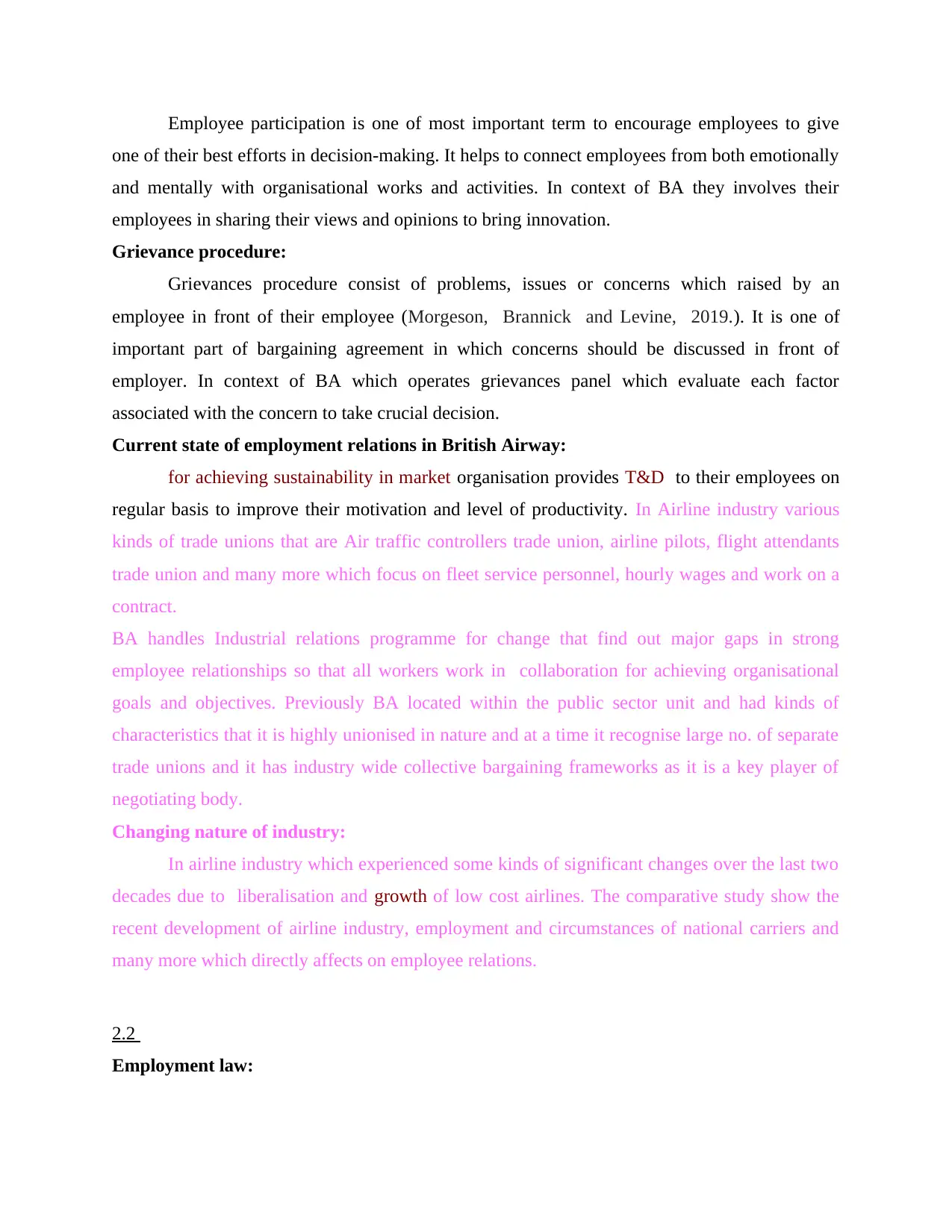
Employee participation is one of most important term to encourage employees to give
one of their best efforts in decision-making. It helps to connect employees from both emotionally
and mentally with organisational works and activities. In context of BA they involves their
employees in sharing their views and opinions to bring innovation.
Grievance procedure:
Grievances procedure consist of problems, issues or concerns which raised by an
employee in front of their employee (Morgeson, Brannick and Levine, 2019.). It is one of
important part of bargaining agreement in which concerns should be discussed in front of
employer. In context of BA which operates grievances panel which evaluate each factor
associated with the concern to take crucial decision.
Current state of employment relations in British Airway:
for achieving sustainability in market organisation provides T&D to their employees on
regular basis to improve their motivation and level of productivity. In Airline industry various
kinds of trade unions that are Air traffic controllers trade union, airline pilots, flight attendants
trade union and many more which focus on fleet service personnel, hourly wages and work on a
contract.
BA handles Industrial relations programme for change that find out major gaps in strong
employee relationships so that all workers work in collaboration for achieving organisational
goals and objectives. Previously BA located within the public sector unit and had kinds of
characteristics that it is highly unionised in nature and at a time it recognise large no. of separate
trade unions and it has industry wide collective bargaining frameworks as it is a key player of
negotiating body.
Changing nature of industry:
In airline industry which experienced some kinds of significant changes over the last two
decades due to liberalisation and growth of low cost airlines. The comparative study show the
recent development of airline industry, employment and circumstances of national carriers and
many more which directly affects on employee relations.
2.2
Employment law:
one of their best efforts in decision-making. It helps to connect employees from both emotionally
and mentally with organisational works and activities. In context of BA they involves their
employees in sharing their views and opinions to bring innovation.
Grievance procedure:
Grievances procedure consist of problems, issues or concerns which raised by an
employee in front of their employee (Morgeson, Brannick and Levine, 2019.). It is one of
important part of bargaining agreement in which concerns should be discussed in front of
employer. In context of BA which operates grievances panel which evaluate each factor
associated with the concern to take crucial decision.
Current state of employment relations in British Airway:
for achieving sustainability in market organisation provides T&D to their employees on
regular basis to improve their motivation and level of productivity. In Airline industry various
kinds of trade unions that are Air traffic controllers trade union, airline pilots, flight attendants
trade union and many more which focus on fleet service personnel, hourly wages and work on a
contract.
BA handles Industrial relations programme for change that find out major gaps in strong
employee relationships so that all workers work in collaboration for achieving organisational
goals and objectives. Previously BA located within the public sector unit and had kinds of
characteristics that it is highly unionised in nature and at a time it recognise large no. of separate
trade unions and it has industry wide collective bargaining frameworks as it is a key player of
negotiating body.
Changing nature of industry:
In airline industry which experienced some kinds of significant changes over the last two
decades due to liberalisation and growth of low cost airlines. The comparative study show the
recent development of airline industry, employment and circumstances of national carriers and
many more which directly affects on employee relations.
2.2
Employment law:
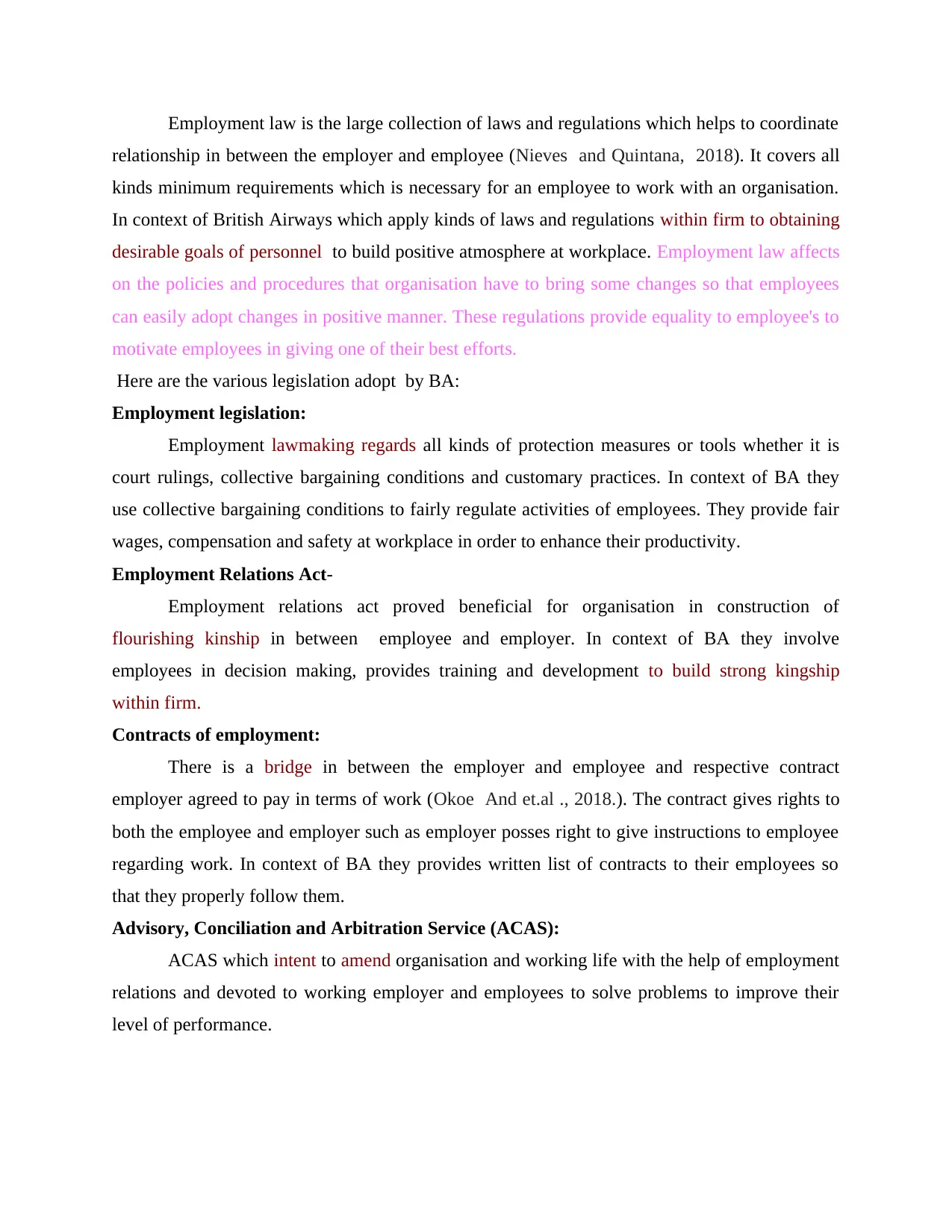
Employment law is the large collection of laws and regulations which helps to coordinate
relationship in between the employer and employee (Nieves and Quintana, 2018). It covers all
kinds minimum requirements which is necessary for an employee to work with an organisation.
In context of British Airways which apply kinds of laws and regulations within firm to obtaining
desirable goals of personnel to build positive atmosphere at workplace. Employment law affects
on the policies and procedures that organisation have to bring some changes so that employees
can easily adopt changes in positive manner. These regulations provide equality to employee's to
motivate employees in giving one of their best efforts.
Here are the various legislation adopt by BA:
Employment legislation:
Employment lawmaking regards all kinds of protection measures or tools whether it is
court rulings, collective bargaining conditions and customary practices. In context of BA they
use collective bargaining conditions to fairly regulate activities of employees. They provide fair
wages, compensation and safety at workplace in order to enhance their productivity.
Employment Relations Act-
Employment relations act proved beneficial for organisation in construction of
flourishing kinship in between employee and employer. In context of BA they involve
employees in decision making, provides training and development to build strong kingship
within firm.
Contracts of employment:
There is a bridge in between the employer and employee and respective contract
employer agreed to pay in terms of work (Okoe And et.al ., 2018.). The contract gives rights to
both the employee and employer such as employer posses right to give instructions to employee
regarding work. In context of BA they provides written list of contracts to their employees so
that they properly follow them.
Advisory, Conciliation and Arbitration Service (ACAS):
ACAS which intent to amend organisation and working life with the help of employment
relations and devoted to working employer and employees to solve problems to improve their
level of performance.
relationship in between the employer and employee (Nieves and Quintana, 2018). It covers all
kinds minimum requirements which is necessary for an employee to work with an organisation.
In context of British Airways which apply kinds of laws and regulations within firm to obtaining
desirable goals of personnel to build positive atmosphere at workplace. Employment law affects
on the policies and procedures that organisation have to bring some changes so that employees
can easily adopt changes in positive manner. These regulations provide equality to employee's to
motivate employees in giving one of their best efforts.
Here are the various legislation adopt by BA:
Employment legislation:
Employment lawmaking regards all kinds of protection measures or tools whether it is
court rulings, collective bargaining conditions and customary practices. In context of BA they
use collective bargaining conditions to fairly regulate activities of employees. They provide fair
wages, compensation and safety at workplace in order to enhance their productivity.
Employment Relations Act-
Employment relations act proved beneficial for organisation in construction of
flourishing kinship in between employee and employer. In context of BA they involve
employees in decision making, provides training and development to build strong kingship
within firm.
Contracts of employment:
There is a bridge in between the employer and employee and respective contract
employer agreed to pay in terms of work (Okoe And et.al ., 2018.). The contract gives rights to
both the employee and employer such as employer posses right to give instructions to employee
regarding work. In context of BA they provides written list of contracts to their employees so
that they properly follow them.
Advisory, Conciliation and Arbitration Service (ACAS):
ACAS which intent to amend organisation and working life with the help of employment
relations and devoted to working employer and employees to solve problems to improve their
level of performance.
⊘ This is a preview!⊘
Do you want full access?
Subscribe today to unlock all pages.

Trusted by 1+ million students worldwide
1 out of 20
Related Documents
Your All-in-One AI-Powered Toolkit for Academic Success.
+13062052269
info@desklib.com
Available 24*7 on WhatsApp / Email
![[object Object]](/_next/static/media/star-bottom.7253800d.svg)
Unlock your academic potential
Copyright © 2020–2025 A2Z Services. All Rights Reserved. Developed and managed by ZUCOL.




